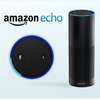Population aging is an increasingly important consideration for health care in the 21th century, and continuing to have access and interact with digital health information is a key challenge for aging populations. Voice-based Intelligent Virtual Assistants (IVAs) are promising to improve the Quality of Life (QoL) of older adults, and coupled with Ecological Momentary Assessments (EMA) they can be effective to collect important health information from older adults, especially when it comes to repeated time-based events. However, this same EMA data is hard to access for the older adult: although the newest IVAs are equipped with a display, the effectiveness of visualizing time-series based EMA data on standalone IVAs has not been explored. To investigate the potential opportunities for visualizing time-series based EMA data on standalone IVAs, we designed a prototype system, where older adults are able to query and examine the time-series EMA data on Amazon Echo Show - a widely used commercially available standalone screen-based IVA. We conducted a preliminary semi-structured interview with a geriatrician and an older adult, and identified three findings that should be carefully considered when designing such visualizations.
翻译:21世纪,人口老龄化是一个日益重要的保健问题,在21世纪,继续获得和与数字健康信息互动是老年人所面临的一项关键挑战。基于声音的智能虚拟助理(IVAs)有望改善老年人的生活质量,再加上生态动力评估(EMA),他们可以有效地从老年人那里收集重要的保健信息,特别是在重复基于时间的活动方面。然而,同样的EMA数据对于老年人来说是难以获取的:尽管最新的IVAA都配有显示设备,但独立IVAs基于时间序列的EMA数据可视化效果尚未得到探讨。为了调查独立IVAs上基于EMA数据视像化时间序列的可能性,我们设计了一个原型系统,使老年人能够查询和审查亚马孙回声节目上的时间序列数据,这是一个广泛使用商业上独立的独立屏幕IVA。我们与一个老年老人和老年人进行了初步的半结构性访谈,在设计这种视觉化时,应当仔细考虑的三种发现。





